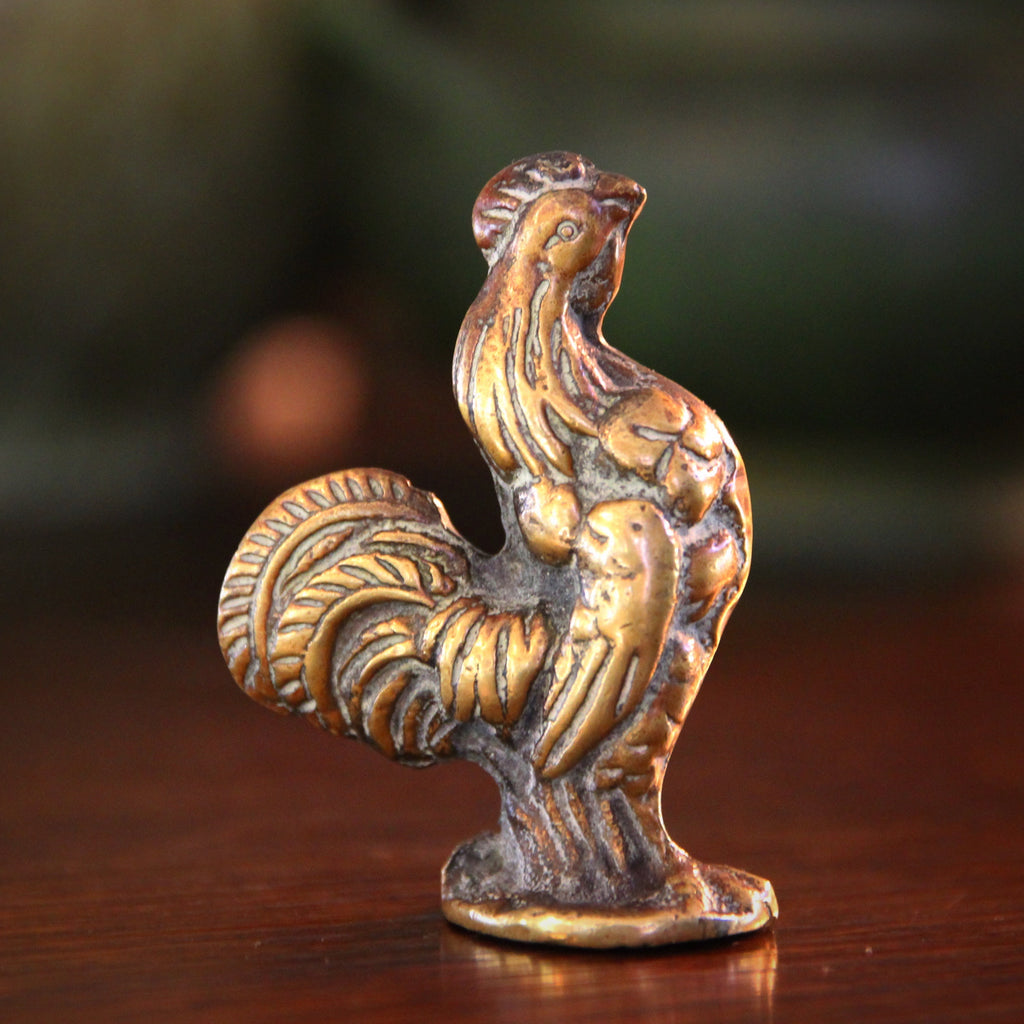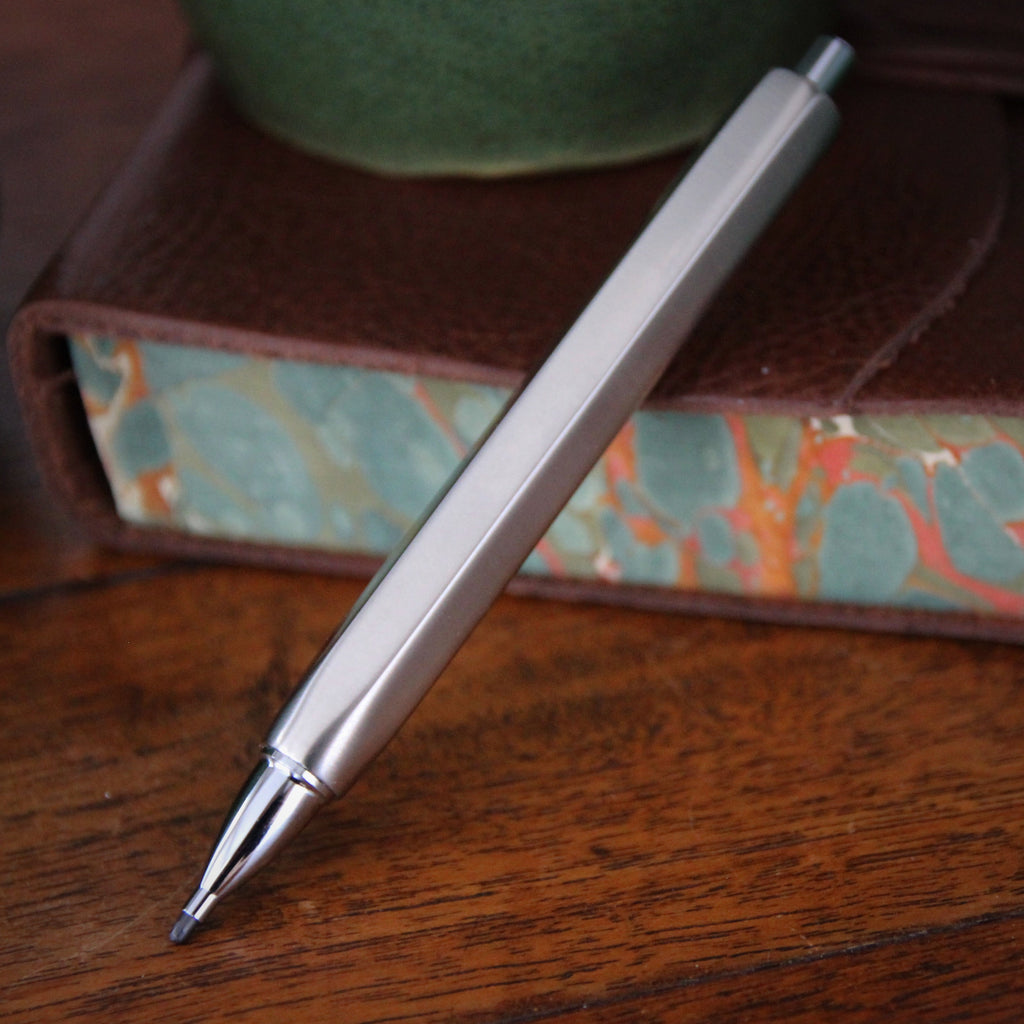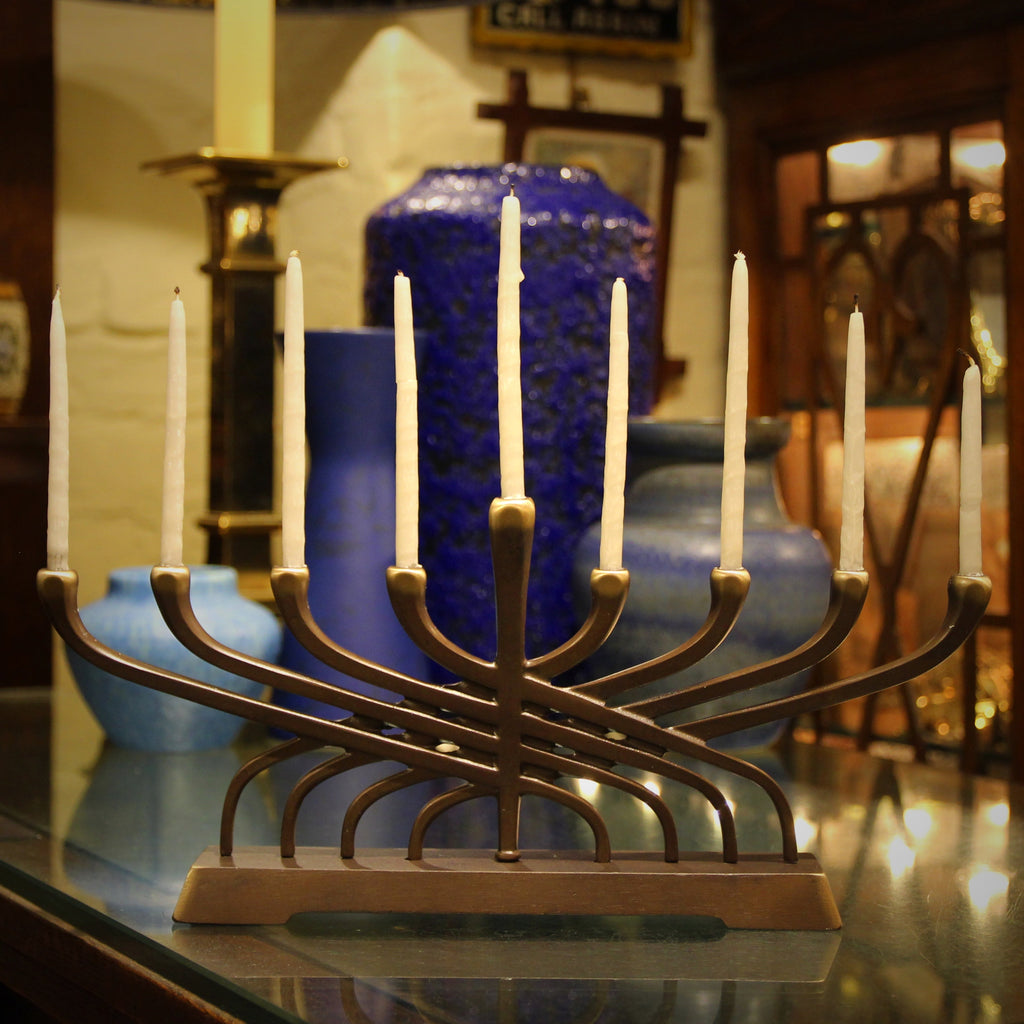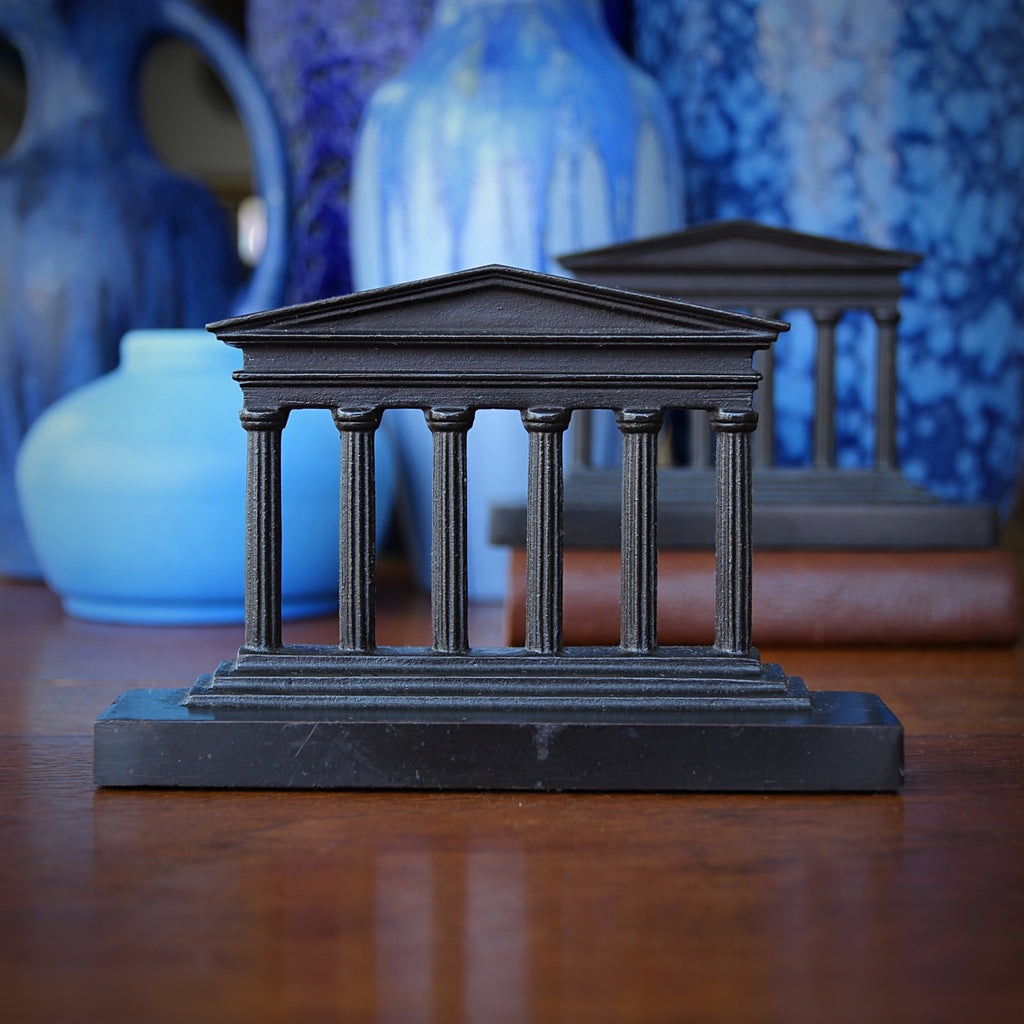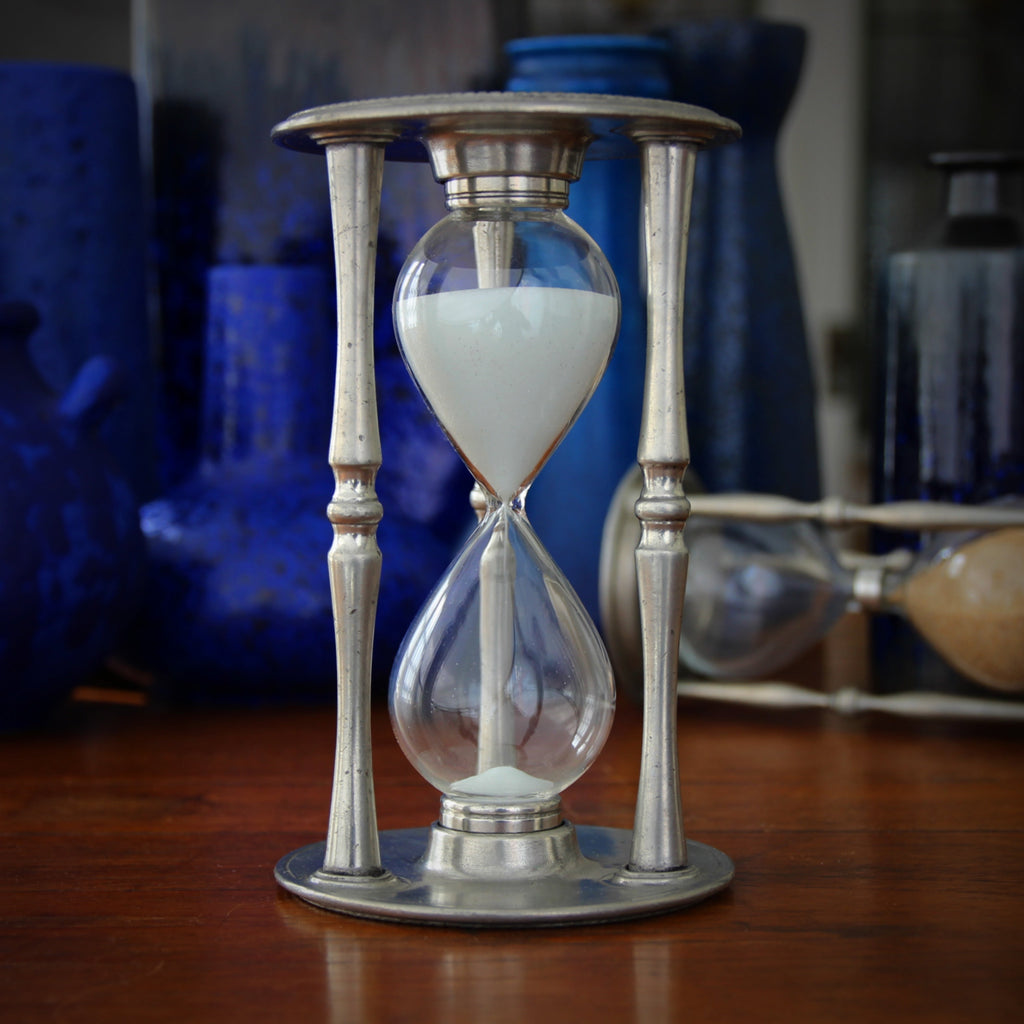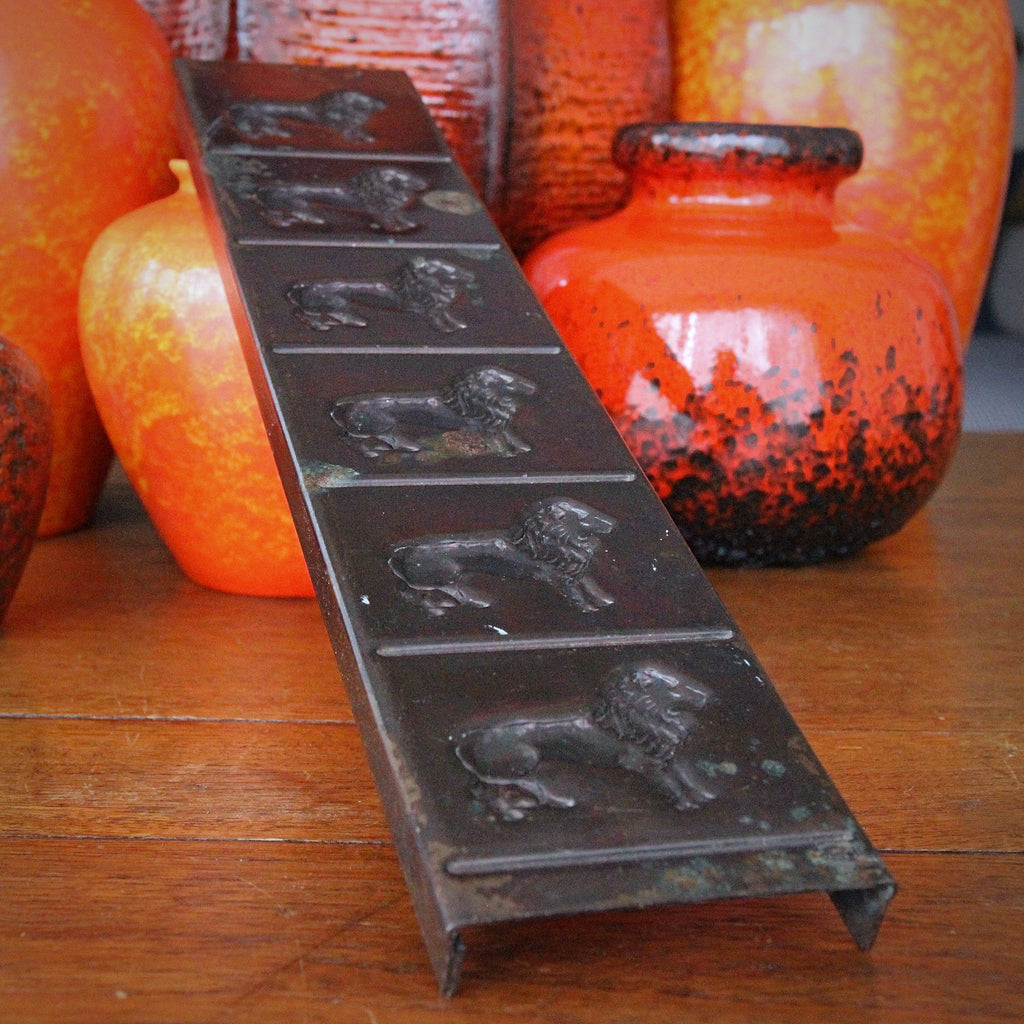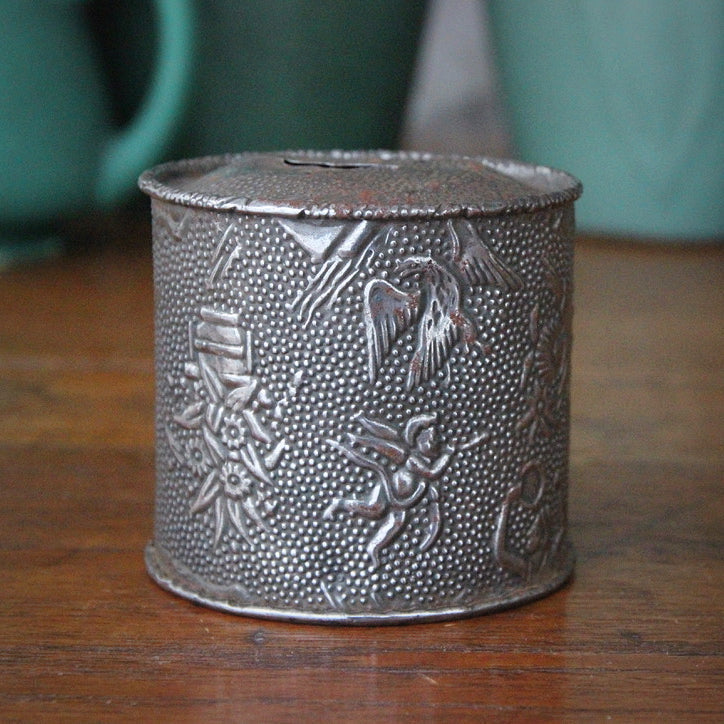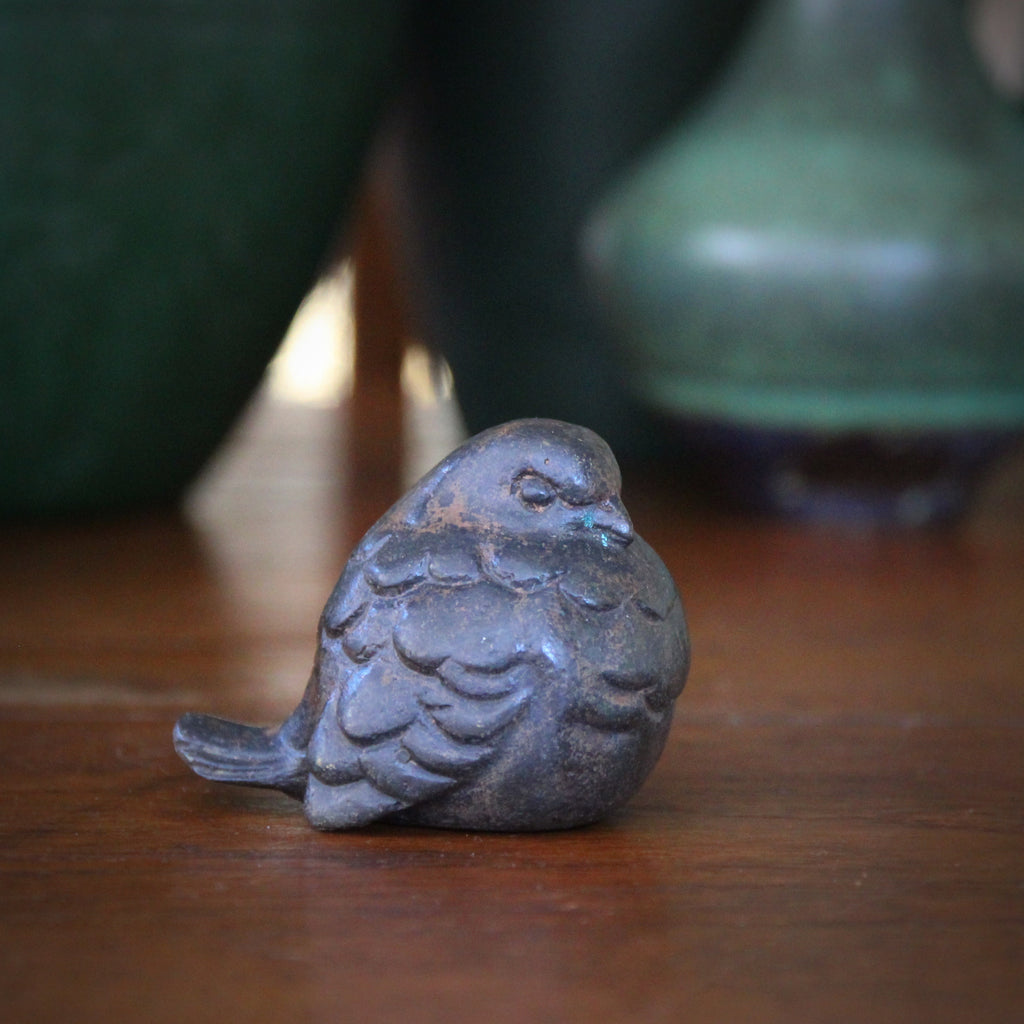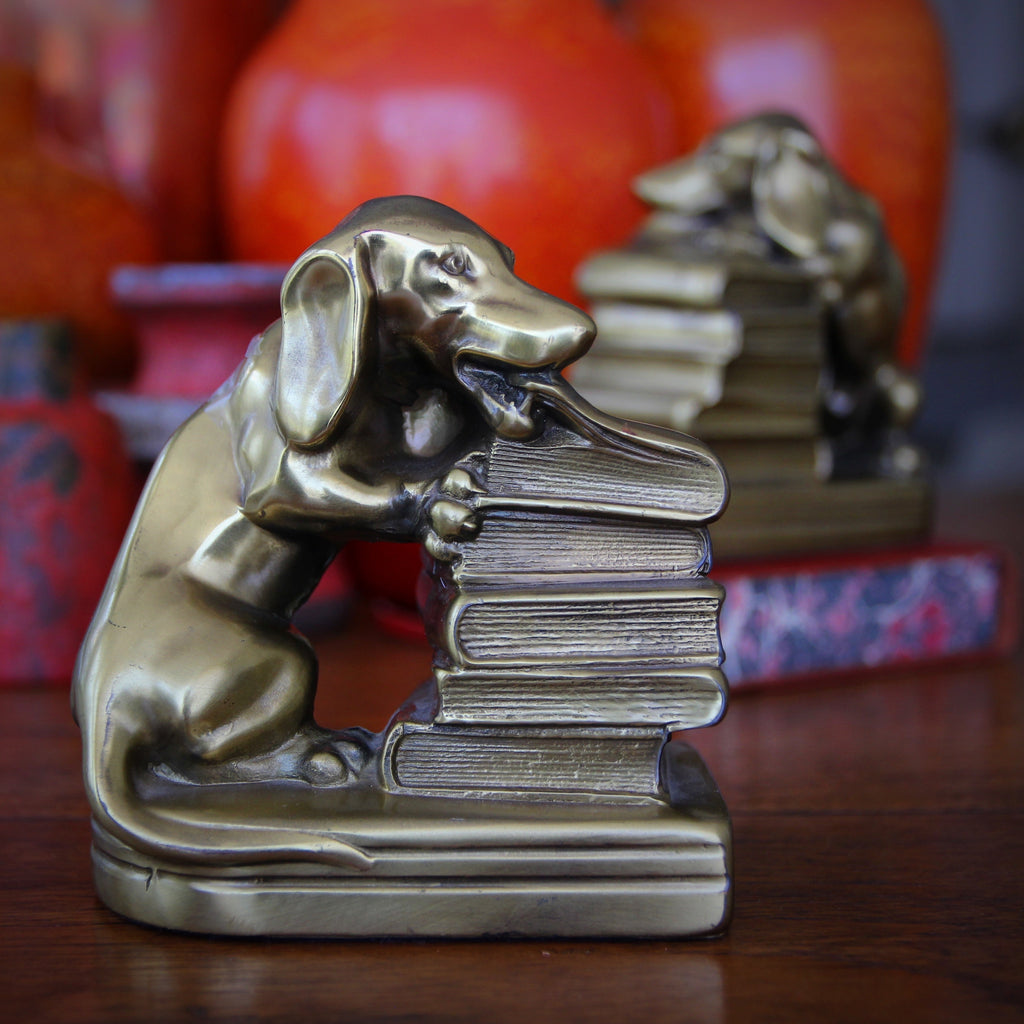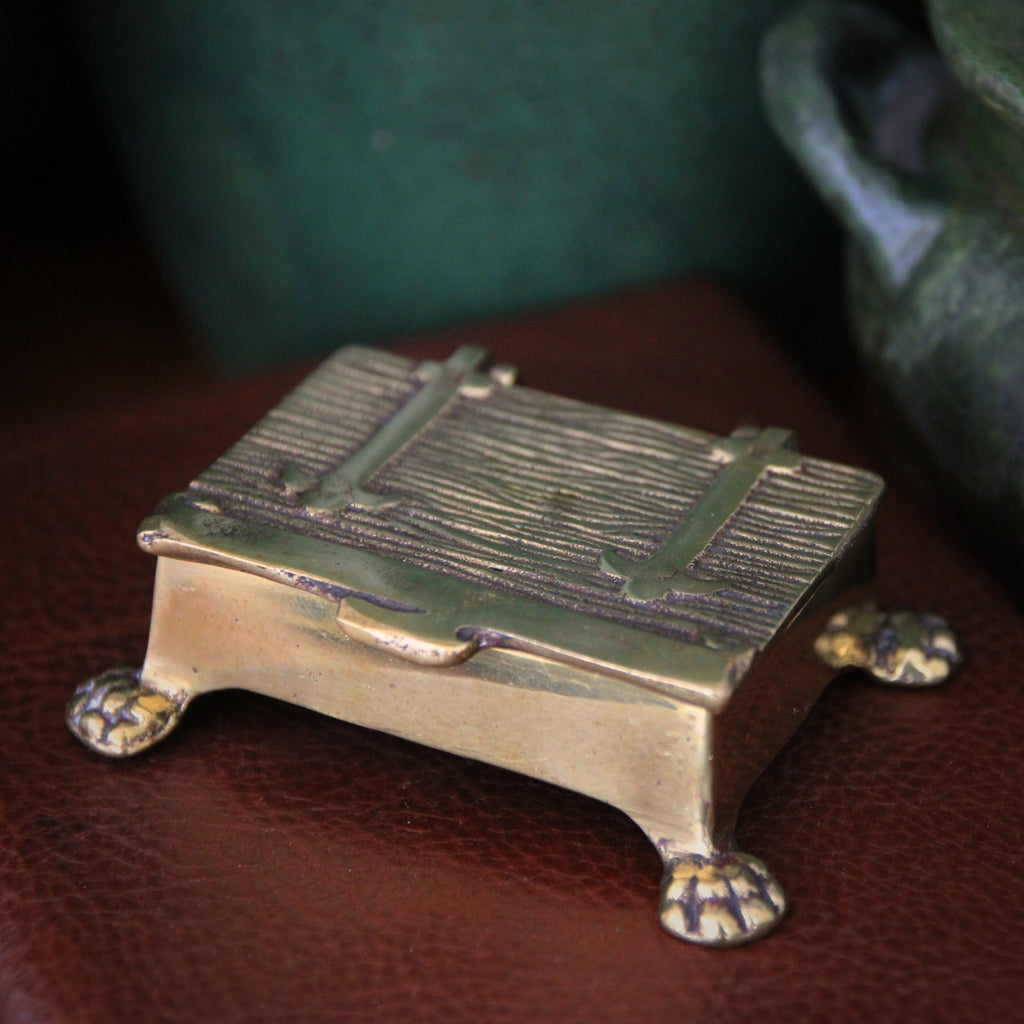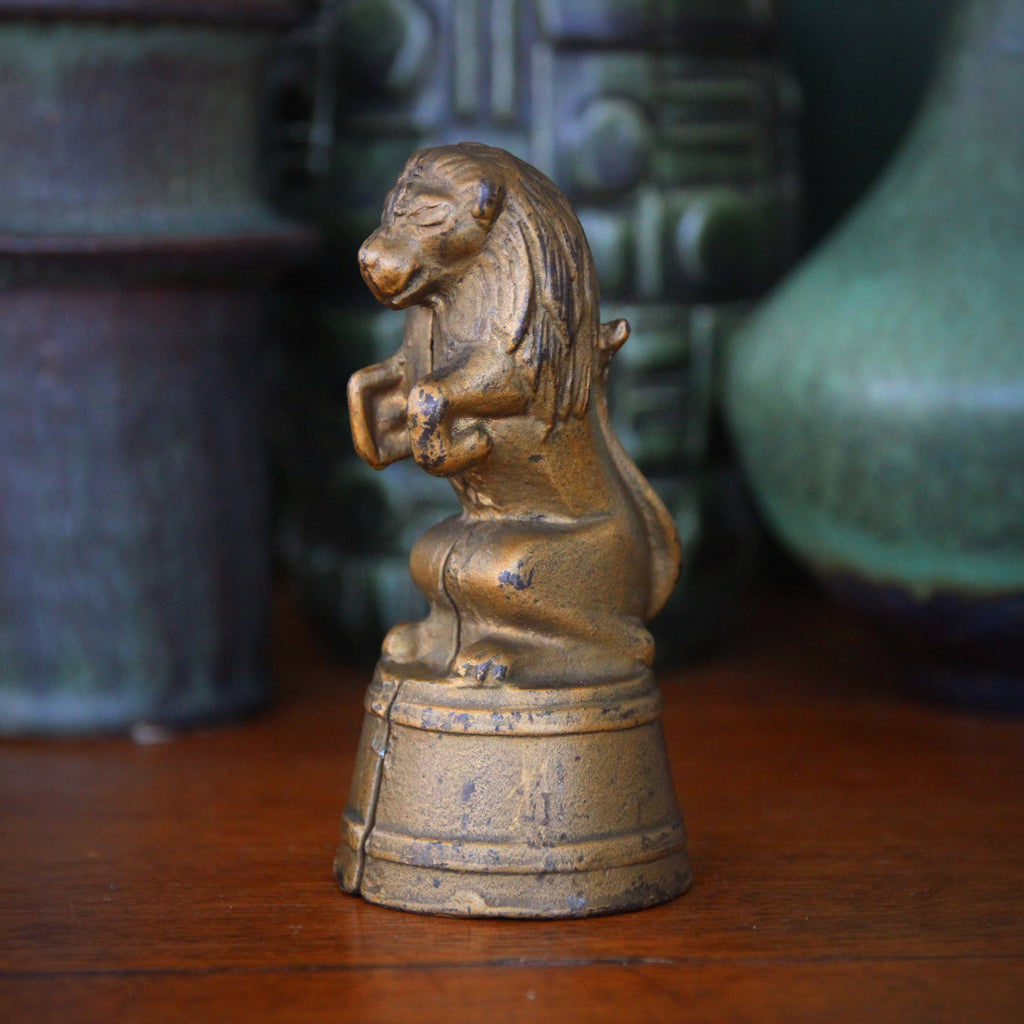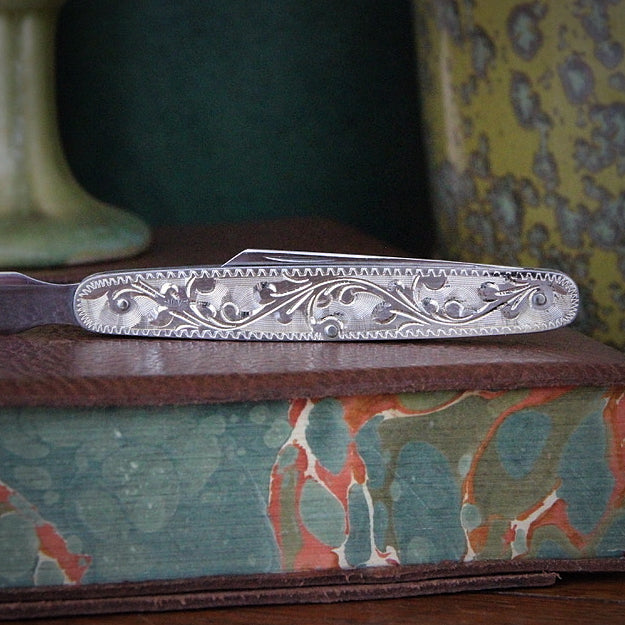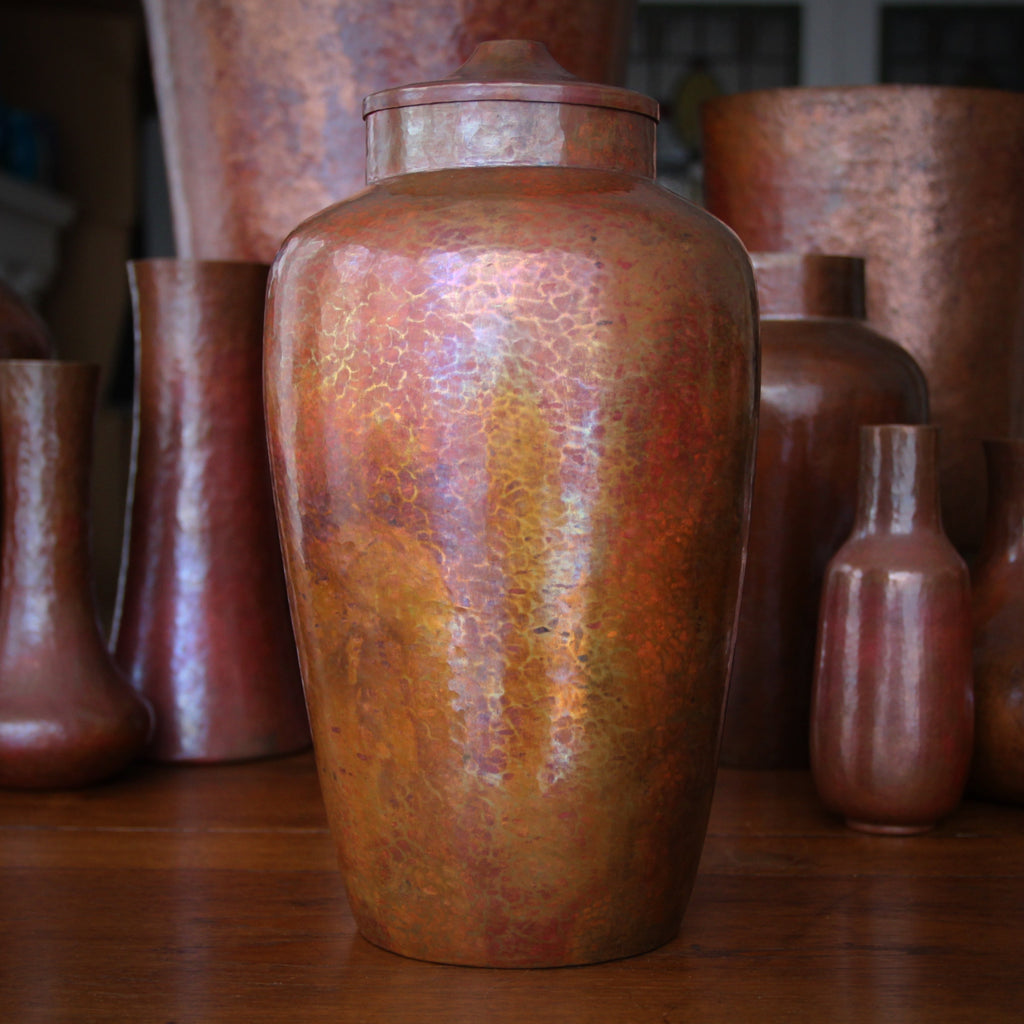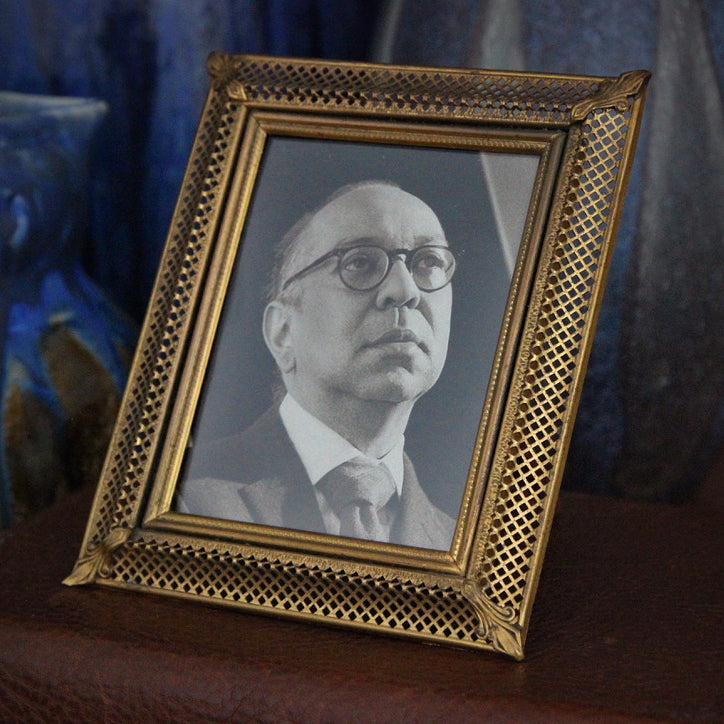JOURNAL — Metalwork RSS
The Art Nouveau Movement was manifested in most European countries, starting in the last decades of the Nineteenth Century until (approximately) World War One. Although Art Nouveau had differing personalities in differing locales, there were several through lines which informed the movement wherever it was practiced. Chief amongst these principles was a return to honorable handcraft—and the revival of specific regional themes (which could be ancient, historic, literary, or artistic). This made the Art Nouveau Movement especially adaptable to nationalist movements—aesthetic fashions which reinforced the culture and national identity of independent countries (or those who wished to be).
Bearing with It - Two
Bronze is such a nice metal. There was even a period called the Bronze Age. While bronze was initially developed for making tools and weapons, it was also a wonderful medium in the hands of artists. Sculpture, furniture, lighting and other home furnishings have been (and still are are) made of bronze.
Shown above, a chubby little "shelf-sitter" teddy bear. He is impressionistically modeled, cast in bronze and finished with a dark patina. His little legs were designed to allow him to sit on the edge of a shelf—legs-a-dangling. Place him within view and he'll keep you company at your desk or reading chair.
Twelfth Night
Twelfth Night, 5 January, refers to The Twelfth Day of Christmas—which is the evening before Epiphany (6 January). Traditionally, it was a time of festive merriment—with just a little bit of sanctioned mayhem. Some believe that William Shakespeare's play (Twelfth Night, or What You Will) was requested by Queen Elizabeth I for that evening's entertainment (in 1601 or 1602).
The heavy, cast iron bookends, shown above, were made over 300 years later (in the 1920's). A golden bust of William Shakespeare floats against a textured, bronze-colored backdrop. It is handsome, stately, and terrifically practical. They are the perfect gift for any educated book-lover—aesthetic and useful.
More Light
Though the days are getting noticeably longer, who can't use even more light? This pair of Mid-Nineteenth Century Victorian English brass candlesticks is a handsome and practical way to bring more light to your table. The square bases are an uncommon design. And the faceted "knuckle" along the shaft makes them easier to carry securely.
Careful Curation
At LEO Design, we always have carried a mixture of Handsome Gifts—some of them antique, some of them newly-crafted. But, because of our large cache of antiques, we have always been careful about not carrying contemporary items which might be confused as an antique. While we do not want people to feel misled, we also are proud to lean-into the excellent craftsmanship of contemporary artisans (when we find them). Thus, very few of our contemporary pieces were outright reproductions, posing as antique items. One rare exception is a line of (wonderful) frames—gold-plated, enameled and hand-set with Swarovski crystals. Consider the "Imperial Gold-Plated" frame shown above. I have loved this line of frames from the moment I first found them. They are...
"Between the Wars"
It's enticing to believe that distinct aesthetic schools start (and stop) on a particular day in history. For example, that the Renaissance ended one morning and Mannerism began that same afternoon. But artistic movements—and the human artists who create them—don't stick to hard-and-fast timetables. Elements of one movement (say, the Aesthetic Movement) still may be visible in the next school of design (say, the Arts & Crafts). Humans—including artists (especially artists)—are often driven by their own creative wills and temporal needs, not the precisely regimented timetables of academicians who will follow in later years (or centuries). It is also true that one nice antiquity may have the "visual genetics" of two or more aesthetic schools (to successful or unsuccessful effect)....
The Greek Key
I have always loved the Greek Key decorative motif. On pottery, on glassware, in architecture or on photo frames (like the one shown above), a little band of Greek Fretwork can never be too much. Often, it's just enough. A Greek Key is a continuous decorative line which "meanders" along an unbroken and repetitive pathway of right angles—always moving forward, taking frequent 90° turns (in both directions) and sometimes undergoing temporary switchbacks. Though a Greek Key almost always progresses in a directional line, the right angles create an interlocking, maze-like appearance. The unbroken line can be interpreted to represent unity, infinity or continuous flow. Sometimes two (or more) Greek Key lines are "interwoven" to create a complex fretwork—highly elaborate but...
Brass
Simply put, brass is an alloy (a metal mixture) of two-thirds copper and one-third zinc (although these proportions can vary, and other metals introduced, to create a variety of desired effects). By changing the composite metals (and their proportions), brass can be manipulated to be better suited to heat, salty conditions, to affect the coloration, or to make a better-sounding musical instrument. Objects made of brass-like alloys have been found since ancient times, however, the proper scientific understanding of brass (and brass-making) really coalesced during the Renaissance. Before that, the brass mixtures were more crudely formulated. What became understood during the Renaissance was the importance of trapping zinc vapors by covering the crucible (the large pot in which metals were...
Happy Boxing Day!
Boxing Day—the day after Christmas—is a national holiday in England and in many of the British Commonwealth Countries around the world (that is, those countries which were once British territories). Boxing Day was the standard day off granted to the household servants of British aristocrats (as staff were expected to attend their employers on Christmas Day). On 26 December, servants would receive "boxes" from their masters containing food, money and other gifts. It was also a day when the poor might receive alms—monies collected by the Church in alms boxes. (Recall the carol about "Good King Wenceslas" who brought charity [alms] to the needy, through deep snow, on the Feast of Saint Stephen—26 December.)
Ting-a-Ling
We live in a modern world of alarms, alerts and other audible signals—many of them emanating from the electronic device waiting in our back pocket. For good or bad, we are now conditioned to respond immediately to any such interruptions—as the signal pierces not only our ears, but our consciousness. Such "call systems" are not new. In the old days, bells and whistles were used to call people to a purpose. Mistresses would ring a little bell when she needed help dressing or wanted the tea brought in. Factory owners would blow a horn when a work shift was about to begin. And teachers would ring a large triangle when it was time for class to assemble. In these old-time...
Winter is Here
Despite several 7° days—and many inches of snow—Winter only begins today. It is the Winter Solstice, the day when the Northern Hemisphere is most tipped-away from the Sun in the Earth's annual "axis-wobble," toward and away from the Sun. That makes today the "shortest day of the year," the day with the least amount of daylight. And, starting tomorrow, the daylight will begin to shine longer and longer. But the coldest months of the year are yet to come. The mercury thermometer, shown above, was made at the Turn-of-the-Century as an "advertising piece"—a giveaway to customers of the Gall & Lembke Optical Company, 21 Union Square, New York City. The thermometer is mounted to an engraved brass plate, attached to...
Organization!
Organization! Each New Year begins with the same resolution: "This year I really need to arrange this . . . or set-up that . . . or create . . . whatever." Perhaps, in its very small way, this Turn-of-the-Century desk accessory will move you just a little closer to this goal. It was made to promote "K-Diamond" (a company which we have yet to identify). Perhaps it was given-away to customers or left-behind by a salesman after a sales call. The cast iron "feet" curl upward—like a pair of boots—providing two convenient spaces to store a pen or pencil. The central spring accepts note cards or letters. Because the spring slides back and forth, the holder will accept envelopes...
Art vs. Utility
When is a tray not a tray? Perhaps when it's too beautiful to cover-up and use—like this Belgian Art Nouveau bronze tray. It was made by G. Huygens, a Belgian sculptor of Dutch ancestry. What this small tray does—superbly—is to provide a sculpted decorative accent upon a table top or low shelf. It would be useful for presenting business cards, offering small (wrapped) candies, or as a caddy for wallets and mobile phones (though I would avoid scratching it with coins or keys).
While the works of G. Huygens can be found at the occasional auction, there is a surprising lack of biography to be found about him.
Happy Hanukkah!
Hanukkah begins tonight at sundown. Wishing all a Happy Festival of Lights! Every great now and then, depending on the idiosyncratic inter-cyclings of the Hebrew (lunar) and Gregorian (solar) calendars, there may be two Hanukkahs in one calendar year. 2025 is such a rarity! Last year's Hanukkah ended on 2 January (2025) and this year's begins on 14 December (2025)—two Hanukkahs in 2025! Even more strange (and more rare) is a year in which where there will be no Hanukkah at all. 3031 (more than a thousand years away) will be such a year with no Festival of Lights (although there will be two Hanukkahs in 3032). This has never happened before—at least not in the 16 centuries since...
Letterknives - V
Let's end our short parade of letterknives with this Rococo Revival specimen—made in England in the Teens or Twenties. Heavy and handsome, it would add dramatic punctuation to any nice desk. The Rococo Movement (of the 1700's) immediately followed the Baroque Period (of the 1600's and early 1700's). While both movements were expensive, opulent and theatrical, they pursued different purposes and each employed a different aesthetic vocabulary. The Baroque (which followed the Renaissance and Mannerist Eras) was a bold and masculine assertion of grandeur, drama, seriousness and dominance—coincident with the Counter-Reformation efforts of the Church which sought to define itself in contrast to the austerity of the breakaway Protestant denominations. The Baroque was noted for its massive scale, symmetry and...
Letterknives - IV
The Japanese letterknife, shown above, is more like a handsome piece of jewelry than a utilitarian desk accessory. The chromed blade extends from a silver handle—ambitiously hand-engraved with scrolling botanicals. Furthermore, a retractable penknife folds into the handle—ever-ready to sharpen one's quill pen. This handsome letterknife was made in the 1950's.
Letterknives - III
Knights in armor continue to stir emotion, even in the modern mind. Dashing, brave and driven by honor, knights gallant hold an honored place in Medieval and Romantic literature. Perhaps it is the chivalry. Possibly it is The Quest. But let's not discount the fancy dress!
This Belgian Art Nouveau brass letterknife takes us back to the Days of the Chevalier. He stands posed atop the letterknife's hilt, mace in-hand at at-the-ready. He might bring a touch of Gothic interest (and usefulness) to the well-appointed desk.
Letterknives - II
This elegant letterknife boasts handsome, scrolling botanical engraving. It is silver-plated and comes with an elegantly decorated sheath. This letterknife is simultaneously understated and theatrical—reminiscent of a stage dagger. It was made between the world wars.
Thankful.
Happy Thanksgiving! We're thankful for many things: our families, friends, good health, and the rare day when the busyness of commerce comes to a standstill (at least for one day). And we're thankful for the blessings of wonderful customers who continue to support LEO Design. May you have a wonderful, safe and relaxing Thanksgiving. Take stock of that for which you may be grateful. And we look forward to serving you in the next few weeks. Shown above, a sculpture of The Sluggard by Sir Frederic, Lord Leighton (1830-1896). While Leighton is best known for his paintings, he did create three exceptional sculptures during his career (all male nudes). One day while Leighton was painting, his handsome Italian model, Gaetano...
Autumn in New York - Part Ten
Let's end our trip to New York with a potpourri of handsome and wonderful items—all from the collection of the Metropolitan Museum of Art in Manhattan.
Shown above, an impressive young man who looks none of his 1,800 years old. He was carved of Schist in (what is now) Pakistan in the Third Century AD. He is called "The Buddha of the Future." I'm sure he would turn-heads walking down the street today.
Next we have a Late Renaissance Roman bronze sculpture—a double-tailed Siren—created in the last decades of the Sixteenth Century. She probably once stood outdoors and up-high—perhaps on a fountain or over a gate—on the estate of the powerful Colonna family of Rome.
Autumn in New York - Part Two
Central Park has been called "the lungs" of New York City. It is also a place of refreshment, regeneration and relaxation. It is surprising how one can feel totally enveloped by nature—and sometimes feel alone—while only minutes from a bustling city of 8.5 million people. This "dose of nature" has a profound civilizing effect upon those who encounter it. Of course, Central Park is a masterpiece of "Man and Nature." The park was highly planned and landscaped. But the genius intent was to create an artistic, naturalistic setting—one which took advantage of the slopes, ravines and boulders—to create the feeling of wilderness. I am always amazed at how many "little, private spaces," numerous nooks and crannies, have been created in...
Home Comfort
The Wrought Iron Range Company was founded in St. Louis, Missouri, in 1881. The company designed and produced top-of-the-line cookstoves, under the brandname "Home Comfort," and they sent their salesmen door-to-door to sell them. Serious customer prospects would be treated to an in-home demonstration. Not only were the stoves well-made, they had thoughtful features and they looked great. They burned wood or coal.
Home Comfort stoves were made of cast iron and wrought iron. Although cast iron is very strong (and much less expensive to produce), it can become brittle—especially under constant heating and cooling. Home Comfort stoves utilized both types of metal to minimize cracking, which sometimes afflicted their competitors' stoves.
Handsome Jewelry
For decades, I've been acquiring cufflinks for LEO Design—a big part of our collection of Handsome Gifts. But, one cannot hunt for men's jewelry without stumbling over (rather, wading through) lots of jewelry for women. In truth, 99% of jewelry I encounter was made for women. Therefore, as I unearth handsome cufflinks, I will see a lot of women's jewelry the process—and occasionally find an intriguing woman's piece which I cannot pass-up. True, the women's jewelry I acquire is usually more on the "Handsome Spectrum" rather than "The Frivolous." And the Norwegian Art Deco bracelet (circa 1920's-1930's), shown above, fits this description perfectly. It was made by David Andersen in Oslo (or, more accurately, by the workshop he founded in 1876,...
Tea Time!
Tea has been consumed by the Chinese—at least medicinally—since the Shang Dynasty (1600 - 1046 BC). In 1516, Portuguese traders arrived in China where they "discovered" the exhilarating brew. Then, in the 1550's, Italian traveler Giovanni Battista Ramusio published his two volume Navagationi et Viaggi ("Navigations and Travels")—fascinating accounts of the travels of the era's greatest explorers. It was here that Europe first learned about the marvelous, caffeinated brew. In 1610, Dutch Traders from the Dutch East India Company began shipping tea to Europe. It was introduced to France in 1635 and England and Germany in 1650. In those early days, tea was a wildly expensive luxury. It was purchased only by wealthy aristocrats and kept safe—under lock and key—in...
Fire Dogs
The Victorian British loved their tools; in any well-appointed home, there was a specific object at-hand to execute any conceivable function. Spoon warmers. Spill holders. Celery vases. Asparagus tongs. And a beautiful Georgian or Victorian fireplace was often punctuated with a pair of handsome "fire dogs." Fire dogs are a pair of small "struts," usually made of a cast or wrought metal: bronze, brass, or iron. They can be found in any of the various styles which were popular during the Eighteenth and Nineteenth Centuries: Neoclassical, Baroque, Rococo, Gothic Revival, Aesthetic Movement, Arts and Crafts. They were not meant to hold-up the burning log (which is the job of the andirons) but, rather, the fire tools for the fireplace....
Suleiman the Magnificent
On this day in 1520, Suleiman the Magnificent became the Sultan of the Ottoman Empire, succeeding his father, Selim I. He was 25 years old and ready-for-action. He promptly initiated bold military campaigns against various European and Mediterranean Christian powers—Belgrade, Rhodes, Hungary—expanding his Empire and imposing his religion and laws on these colonies. His reign represents the highpoint of the Ottoman Empire, a territory of 25 million inhabitants. Besides military conquests, he was known for "harmonizing" (blending) the religious laws with the monarchic laws, thus he is sometimes called "Suleiman the Lawgiver" (especially in the Islamic world). He was also a great patron of the arts, literature and fine culture.
Good King Wenceslaus
On this day in 935, Wenceslaus I, Duke of Bohemia (sometimes called "Václav the Good") was murdered by his brother, Boleslaus I (called "Boleslaus the Cruel"). Wenceslaus was remembered as a good and charitable ruler and his martyrdom elevated his legend. His life exemplified the virtuous concept of "The Righteous King" (Rex Iustis)—a leader who demonstrated piety, charity and vigor. He quickly became a subject of local veneration and was declared a saint in very few years. The legend of his goodness spread, especially his generosity giving alms to the poor, orphans, widows, and prisoners. He was crowned "King" after death and (in 1853) became the subject of the English Christmas carol, "Good King Wenceslas."
William the Cockerel
On this day in 1066, Guillaume le Conquérant set sail from the mouth of the Somme River in France. He was leading a fleet of French ships to England to claim what he believed was his—the English Crown! William would ultimately kill his competitor at The Battle of Hastings, namely, Harold Godwinson (who also believed that the crown rightfully was his). This profound event ended the Anglo-Saxon reign of England and inaugurated the Norman Conquest (and the "Modern Age" of the English monarchy). This seismic change affected all aspects of English life: the monarchy, government, culture, language and religion. Today's King Charles III is a descendant of William the Conqueror. Before becoming King of England, William had been the Duke...
"And, In This Corner . . . "
On this day in 1960, the first of four televised presidential debates was held in Chicago between Vice President Richard Nixon and Senator John F. Kennedy. It was broadcast nationwide by CBS. Prior to this, presidential debates were never de rigueur. They are not constitutionally-mandated and, certainly, none had ever been televised before. 66 million viewers tuned-in (out of a US population of 179 million). Each candidate was given eight minutes for an opening statement, three minutes for a closing statement, and 2.5 minutes to answer each of the questions posed by the moderator, Howard K. Smith. The focus was on domestic policy issues. Going into the debate, Nixon held a six point lead over Kennedy. He was the sitting...
Three Months 'Til Christmas!
Has the countdown begun? It's three months 'til Christmas! To help you get into the spirit, a vintage Sixties cookie tin—bright red with a screened Santa on the cover. It was made for Laub's holiday cookies. Laub's was founded by German immigrant, Jacob Laub, in Cleveland, Ohio, in 1889. In time, it became the largest independent baker in all of Ohio with a bakery storefront, bread delivery routes, and a brisk wholesale operation to restaurants, hospitals and grocery stores. The tin is still great for presenting your homemade cookies—or holding any number of Christmas-related items: ornaments, ribbon, or ornament hooks. It is also a nice place to store vintage Christmas cards and photos—the ones you'd like to save for future...
National Punctuation Day
Is punctuation passé? Perhaps it is amongst "the texting generation." Nowadays, capitalization, commas, and periods seem to be treated as . . . optional. While I do text (frequently), I do make every effort to punctuate properly. I attempt to proofread a text message before I hit that blue "send" arrow. With so many norms and standards falling-away (daily), I feel more compelled than ever to keep up the fight—including with my punctuation. Several years ago, I purchased Lynn Truss's book, Eats, Shoots and Leaves. The cover depicts a particular panda removing the title's offending comma. He wants to make it clear that he eats shoots (he doesn't shoot and leave.) I recently came across another argument for the proper...
Shanah Tova
Shanah Tovah and a Happy 5786!
Today is the first day of Rosh Hashanah—the Jewish New Year—which began at sunset last night. The modern holiday is celebrated for two nights, after which comes a period of reflection and repentance before Yom Kippur—the solemn Day of Atonement (the holiest day of the Jewish calendar).
The name Rosh Hashanah is translated as "head of the year," that is, the New Year. The celebration marks the beginning of the civil year and it is also the traditional anniversary of the creation of Adam and Eve.
Autumn is Here
Today is the Fall Equinox—the day in which daylight and nighttime are of (approximately) equal length. The Autumn season begins today at 2:19 pm and each day's darkness will become increasingly longer until 21 December (the Winter Solstice). The Earth spins on an axis which "wobbles" slowly—back-and-forth—first tipping the Northern Hemisphere closer to the Sun and then tipping the Southern Hemisphere closer to the Sun. This annual tipping creates the seasonal light and temperature differences in each part of the world. Today, the axis is angled (more-or-less) straight up-and-down. The Northern and Southern Hemispheres both have "equal day and night." Starting tomorrow, the daylight will get longer in the Southern Hemisphere while it becomes shorter in the North. On-and-on the...
"Long Live Absolute World Peace"
Today is the International Day of Peace. The United Nations established the commemoration in 1981 and it was first observed the next year. The aim of the celebration is to envision (and work towards) a world absent of war and violence. Japan is very aware of the human cost which comes from military aggression. In 1954, Japan presented the United Nations with a "Peace Bell" which was then installed in a Japanese garden on the U. N. grounds. It is a Bonshō style temple bell and it was cast from coins donated from all over the world. Besides current and old coins other metal objects were melted-down to form the bell: bullets, war medals, military badges, even saber guards. Pope...
Magellan Sets Sail
Spices are big business. During the "Age of Discovery"—which began around the time of the Renaissance—daring seafarers played a huge role in pursuing new routes from Europe to Asia. Their ultimate goal was to improve trade routes and make money for their king and country (who usually paid for such expeditions).
Portuguese explorer Vasco da Gama sailed from Lisbon, arriving in India on 20 May 1498. He was the first European to sail all the way to India. Such a journey required sailing through the rough and treacherous waters off the southern tip of Africa—called The Cape of Good Hope—where the Atlantic and Indian Oceans violently converge.
Talk Like a Pirate Day
On 6 June 1995, two friends in Oregon—John Baur and Mark Summers—were playing a friendly game of racquetball. Ouch! Pain! "Aaarrrgghh!!!" shouts one of them. And thus was born "Talk Like a Pirate Day." The friends decided to formalize the commemoration, however, 6 June was unsuitable as it was the anniversary of D-Day, the Landing at Normandy. Mark suggested they set the date for 19 September—his ex-wife's birthday.
The men contacted the Miami Herald humor columnist, Dave Barry, who wrote about (thus promoting) the novel occasion. Since then, people (of a certain disposition) have taken to the event—celebrating the day in their own specific ways (though the phrase "Aaarrrgghh!!!" is usually a part of the fun).
The End of the Trail
Today is the National Trail of Tears Commemoration Day—which marks the day in 1838 when the last of the (surviving) Cherokee Indians completed their forced march from their homeland (in the American Deep South) to the newly-christened "Indian Territory" (now called Oklahoma). As the country's population of European-Americans grew, they began to petition the federal government to clear the Indians from the American Southeast—territory which the white settlers wanted to inhabit. When gold was discovered in Georgia in 1828, the drumbeat intensified. They found an enthusiastic advocate in President Andrew Jackson who pushed-through the Indian Removal Act of 1830, legislation which authorized the federal government to relocate members of the "Five Civilized Tribes" including the Cherokee, Muscogee, Choctaw, Chickasaw and Seminole...
The International Day of Democracy
In 2007, the United Nations resolved to mark 15 September as The International Day of Democracy—and the commemoration has been observed since 2008. The UN sought "to promote and uphold the principles of Democracy, encourage member states to commemorate the day, and work to raise public awareness of the need to protect Democracy." Has your country's leader promoted the date?
What is Democracy? The United Nations defines Democracy as the "universal values based on the freely-expressed will of people to determine their own political, economic, social and cultural systems."
Time Flies
On this day in 1752, Great Britain adopted the Gregorian Calendar, thus abandoning the Julian Calendar which it had been using for over 1700 years. This switch of systems meant of a loss of eleven days. The people of Great Britain (and its possessions, including the Original Thirteen American Colonies) went to sleep on Wednesday 2 September and woke-up the next morning, Thursday 14 September. For those who thought Y2K might be disruptive, the change to the Gregorian Calendar was truly a shake-up! The older, Julian Calendar was adopted in 45 BC (under the dictator, Emperor Julius Caesar). It accounted for a 365 day year, plus a leap day every fourth year. Although this was fairly accurate, it was still...
International Chocolate Day
Today is International Chocolate Day (not to be confused with World Chocolate Day, 7 July). It is also the birthday of chocolatier and philanthropist, Milton Snavely Hershey—born on this day in 1857. Hershey was born into a Mennonite family in Derry Township, Pennsylvania, and grew-up speaking Pennsylvania Dutch. He left school after the fourth grade and began working (including apprenticeships under several confectioners). His first two (short-lived) businesses were in Philadelphia and New York. But, having learned how to make caramels, Hershey returned to Lancaster, Pennsylvania in 1883 where he founded the Lancaster Caramel Company. The company was a grand success. By the Turn-of-the-Century, Hershey was employing 1300 workers. In 1900, he sold the company for $1 million, allowing him...
We Choose to Go to the Moon
On this day in 1962—a warm and sunny Texas day—President John F. Kennedy stood before 40,000 spectators in the Rice University Stadium. He laid-out his vision for America's essential leadership in "the space race." "I believe that this nation should commit itself to achieving the goal, before this decade is out, of landing a man on the moon and returning him safely to Earth." He added, "We choose to go to the Moon in this decade and do the other things, not because they are easy, but because they are hard." His goal (and the speech which inaugurated the campaign) was a challenge to Americans to show the world (and themselves) that the U.S. could do great things—for the benefit...
Donkey's Years
Donkeys—about 40 million of them worldwide, divided amongst some 185 varieties—all originate from the African Wild Ass (Equus asinus asinus). For centuries, the word "Ass" was the universal name for the creature (even in the Bible). Males were called "Jacks" or "Jackasses." Females were called a "She-Ass." But, starting in the Eighteenth Century, the name became viewed as, shall we say, impolite? (It was the same time that "cocks" became "roosters" and "coneys" became "rabbits.") "Donkey" has become the most popular (English) name, to this day.
Johann David Hollenbach
Johann David Hollenbach (1810-1871) was an esteemed Viennese metalwork designer, bronze caster and metal fabricator. He produced his own designs but also cast (or crafted) the metalwork creations for other artists and designers. His foundry cast bronzes for sculpture artists and produced the metal "mountings" which were used as components for larger pieces (for example, the bronze decorative elements which might be mounted upon a clock or a piece of furniture). Hollenbach's works embellished the finest homes, palaces and cultural institutions—in Vienna and farther afield. He served the Habsburg family (including the Emperor, Franz Josef), as well as Napoleon III of France and the Russian Tsar's royal family. He created the magnificent electrified candelabras in the Vienna State Opera. And...
More Sapphire - I
We're celebrating September's birthstone—the sapphire—by sharing some of our favorite items which tip-the-hat to the regal blue stone.
Shown here, a bronze presentation "casket" decorated with sapphire glass cabochons. It was made in the Teens or Twenties, specifically to present a pearl necklace by La Tausca. Although La Tausca made synthetic pearls, they were still a luxury item—which required a luxurious presentation. La Tausca synthetic pearl necklaces would come in ambitiously crafted boxes like the one shown here.
This bronze casket is decorated with sapphire glass cabochons and filigree mounts.
A Penny Saved . . .
The US Mint has announced that it will discontinue the production of pennies in early 2026. It seems that the humble penny is yet another American institution which will not survive the nation's Semiquincentennial. The Philadelphia Mint "struck" the first official US Penny in 1793, the year after the Mint was established by Congress. It has been copper (or copper-plated) ever since. From 1859 to 1909, the Mint produced the "Indian Head" penny. Then, in 1909 (which was the Centenary of Abraham Lincoln's birth), the Mint produced the Lincoln Penny with the president's profile on the obverse (and wheat sheafs on the reverse). This coincided with a period of "Lincoln Mania" in America—and the public really embraced the new coin....
Bird Watching - VII
Let's end our week of birds with this graceful bronze swan. She will glide endlessly across your desk or windowsill—a reminder that elegance is often accompanied by tremendous strength and determination.
Bird Watching - V
Every delicate detail of this pair of sparrows has been captured by the sculptor—feathers, eyes, even the quizzical cock of the head. They are cast in brass then finished with a verdigris bronze patina. The pair would love to spend their winters indoors, with you—on a shelf, mantelpiece or windowsill—though they could endure a life outdoors (where they will age in the weather).
Bird Watching - IV
As Summer comes to an end—and the winter chill sets-in—the birds scurry about, preparing to hunker down in the snow or fly away South. We're sharing some of our favorite birds with you this week, all currently in-stock at LEO Design.
Two nest eggs shine from within their bronze nest—a textured "bowl" which is useful for so many other things. The juxtaposition of shiny bronze against rustic bronze gives great character to this piece.
Bird Watching - III
Don't let the appearance of this crusty and weathered parrot mislead you. The tinkle of this tea bell is sweet and clear—perhaps to the disappointment of the Irish maids (like my grandmother) who were expected to respond quickly to his call. Made of bronze in the late Nineteenth Century, it was colorfully "cold-painted" after being cast and chased (cleaned-up of burrs and roughness). Over the years, much of the paint has worn-down. But his worn visage reveals tremendous character. I can see Miss Havisham ringing this bell, summoning Pip into her sitting room, where she rocks in her decades-old wedding dress. I nearly expect the parrot to answer her questions!
Bird Watching - I
At this time of year—late in the summer, heading towards autumn—I see the birds busily scurrying-about, preparing for the winter chill to come. I imagine that they are eating as much as they can, preparing for a long flight south (or a cold hunkering-down here in Pennsylvania). Over the next several days, we'll be sharing som of our favorite birds, now in-stock at LEO Design. This little fellow, round as a ball, seems to be well-prepared for the coming season. Perhaps he is too well prepared? Can he still even fly? His fluffed-up feathers suggest that he's preserving heat—or that he's a little miffed, at what we will never be sure. He's made of cast brass, finished with a verdigris...
The Dog Days of August - I
We're marking the last few days of The Dog Days of Summer (which ends today) with a sampling of our collection of handsome dogs—all currently in-stock at LEO Design.
Here is another charming pair of canine bookends. These were made in the Seventies by "Philadelphia Manufacturing Craftsman." The company was founded by the Startzman family in 1911. Initially, they fabricated metal parts for other manufacturers. In the Fifties, they added "slush-metal" bookends to their production, using old moulds which they had purchased from other bookend makers and some of their original designs. In the Seventies, they moved to Florida and continued to produce bookends.
The Dog Days of August - II
I love dogs. Especially my dog. But I do love all dogs—whether real, painted, sculpted or photographed. I also love books. And I love sculpture. Thus, it will be no surprise, that bookends are a large and cherished part of the collection at LEO Design. Bookends tick many boxes for me. The "Golden Age of American Bookends" flourished between the wars, in the Twenties and Thirties. This is the era in which art and good taste, combined with accelerating industrial mass production, resulted in the country's biggest and most-varied output of excellent bookends. Cast iron was the most common material employed. Solid bronze was used, to a lesser extent. Hollow cast spelter (white metal) was used sparingly (though it would...
The Dog Days of August - III
This quirky little pet brings with him a touch of whimsical charm. Charismatically sculpted and cast in polished bronze, his feet reveal a little secret: the letters L-I-F-E imprinted on the bottom of each paw. "Dog's Life." The phrase was coined in the 1500's to refer to an unhappy and miserable existence—such was the lot of dogs at the time. Today, however, most dogs have a rather charmed existence—at least my pup, Benji, does. I wish for the day when all dogs (and cats and birds) can enjoy such a wonderful dog's life.
The Dog Days of August - IV
The "Dog Days of Summer" are upon us. This year, they occur from 3 July through 11 August. As we count-down the last four days of the season, we'd like to share some of our favorite canines, now in-stock at LEO Design. Sirius—called "The Dog Star"—is the brightest star in the sky. Astronomers have noted and tracked it for thousands of years. They charted its annual appearance and movement through the skies and, eventually, began to anticipate when it should return . Dies Caniculares ("The Dog Days") begins when Sirius makes its first appearance on the horizon at dawn (this year, 3 July). By coincidence, this is the hottest time of the year (in the Northern Hemisphere). Ancient Greeks and Romans...
August's Sardonyx - VI
Handsome meets Lovely in this Scottish sardonyx and sterling silver brooch from the island of Iona. A bold striped cabochon-cut stone is set within a sliver Celtic scrolling botanical mounting. It was sent to Edinburgh in 1962 for hallmarking. The holy island of Iona has sustained a mystical prominence for centuries. Irish saint, Columba (521-597 AD), built a monastery on this windswept island in 563 AD. Today, Iona is one of the oldest continuously-operating religious locales in Western Europe and many Christians make pilgrimages to its Abbey each year. The island's calm, natural beauty, handcraft and religious history makes it a compelling place for Christian retreat and communal living. It was here that Celtic Christianity was established. The iconic carved...
Cloisonné
Cloisonné is the French word for the artistic enameling technique in which a metal surface (usually copper or brass) is artfully subdivided with metal wires or strips to create small fields—each holding a different color of enamel. Glass powder is blended into a paste and applied to each field (called a "cloison") following the designer's color plan. Once the colored pastes are applied, the piece is fired in a kiln (to melt, that is "vitrify," the glass powder into enamel). Once the piece has cooled, it is polished to create a smooth, lustrous surface. In some cases, whole gemstones were cut-to-fit and inserted into the fields. But the use of glass enameling was a quicker, less costly way of achieving...
Welcome, LEO!
Today is the first day of LEO. It is also my birthday! On this day, thirty years ago, I remember (very clearly) spending half the day on my hands and knees, belt-sanding the edges of the wooden floors at 413 Bleecker Street, my first shop in Greenwich Village. I remember that I only worked 8 hours that day. Since it was my birthday, I took it (a little) easy on myself. Most days—seven days a week—were quite long and truly exhausting. I was working alone (I could afford little help) and I really wanted to open-up the shop before the season of LEO had come to an end. I didn't hit that early goal; I opened on Tuesday 29 August,...
Countdown to LEO - 1
This handsome—and slightly startled— LEO seems to be saying, "Are you talking to me?" The sculptor created a bronze sculpture with character and personality—not the standard, stalwart lion. Nevertheless, this LEO remains regal, despite his quizzical mien.
Countdown to LEO - 2
Lions have always been a popular theme in art, literature and the decorative arts—throughout history and in all places. I suppose it's the lions' nobility as well as their bravery, skill and beauty.
In the decorative arts, when a whole lion is not required, sometimes his paws alone might make an appearance. Carved wooden lion's paws are popular in furniture. Cast iron paws might be used in "street furniture" (light fixtures, gates or fences). And sculpted bronze paws are found on everything from lamp bases to andirons.
Shown here, a little Edwardian English cast brass stamp box. Its lid is fashioned like a strap-hinged trunk and the box stands upon four lion's paw feet.
Countdown to LEO - 3
Most lions featured in art and culture focus on the males—regal specimens with lithe, muscled bodies and glorious manes. Yet, 75% (or more) of adult lions in the wild are female! Certainly, we should give the lady lions a little more attention. Especially since the lionesses do most of the hunting and raising of the young. But, regrettably, this gender imbalance amongst lions highlights the tragic fate most of their males face: a gauntlet of life-or-death challenges under the constant spectre of Darwin's "Survival of the Fittest." These "Leonine Social Dynamics" illustrate a grim picture of the raw, unforgiving "Law of the Jungle." Lions are organized within tight, durable family groups called prides. There is one dominant male, a few...
Countdown to LEO - 5
We're a few days away from LEO—which begins 23 July—when the Sun moves into that celestial lion's Territory-in-the-Sky. For the next few days, we will count-down the days 'til LEO with a selection of our favorite leonine items—currently in-stock at LEO Design.
Shown here, a cast iron "circus lion" bank from the early Twentieth Century, wearing his original gold paint. Cast iron banks (and mechanical toys and door stops) were very popular at the Turn-of-the-Century—and several Northeastern factories expanded to mass produce them.
This bank is made of two separate pieces, held-together with a screw. I have not tried to unscrew the two halves, not wanting to strip the screw or "break-the-bank."
Oh, Thank Heaven . . .
It's Seven-Eleven! And, when I think of 7/11, it conjures the word "convenience." In our modern world—with so much coming at us all the time—I (try to) rely on habit and discipline to help smooth the (otherwise) rough edges of getting through the day, on time. For me, I could not function without designating a place to keep my "exit essentials": keys, wallet and various "membership cards" which I need at different points in my schedule. In our household, we have a handsome French ceramic pie plate, glazed navy blue on the outside, glazed white on the inside (complete with a beautiful ruffled edge). It was the wonderful gift of a friend, Steve Leamer, who once made us a pie...
Sheffield Plate
Henry Wilkinson was born in 1788 in Norton Hammer, a village in Southern Yorkshire, some three miles south of Sheffield. Sheffield was already playing an outsized role in England's Industrial Revolution: specifically steel manufacturing, cutlery-making and the production of other metalwares.
At the time Wilkinson was born, silver-plating was only a few decades old. The process of bonding a thin layer of sliver to a copper ingot—and then rolling-it-out into a workable sheet—had been developed and improved in Sheffield. These sheets could then be stamped (in metal forms) to produce cutlery, trays, and all manner of silver-plated wares—commonly called "Sheffield Plate."
Opening in Style
Most of the letter knifes we have offered over the years have tended toward the heavy and masculine—like a prop out of Tosca, Act II. The elegant letter knife, shown here, is more subtle. It is fashioned of tapering stainless steel and is set within a silver handle, hand-engraved with scrolling botanicals. The handle conceals another little bonus: a folding stainless steel pen knife. As useful as it is, this knife is still very elegant—an object of sophisticated refinement. It was made in Japan in the Fifties.
Murray the Outlaw of Falahill
Murray the Outlaw of Falahill (1940-1952) was President Franklin D. Roosevelt's beloved Scottish Terrier. He was named after one of the president's Scottish ancestors. But he was best known by his nickname, Fala. He was FDR's constant companion—usually to be found curled-up in the same room as the president. He even travelled with Roosevelt. Fala was an American institution. He frequently was mentioned-by-name in the press. And, during the Battle of the Bulge in World War Two, "Fala" became the secret code word for American soldiers to identify themselves to their comrades. At the moment Roosevelt died in Warm Springs, Georgia, on 12 April 1945, Fala—who had been lying quietly in the corner of the room—jumped-up snarling and barking....
Biscuit Tins
In 1822, Joseph Huntley opened a biscuit and confectionery shop in Reading, Berkshire, an important stop along the stagecoach route between London and the West of England. Huntley's shop was across from the town's major inn and his customers were the travelers who lodged there for the night. In order to protect his biscuits from being crushed, he packed them in metal tins. His son, also named Joseph, opened a factory for producing the tins. Before long, the idea was hatched: why not make the tins beautiful and collectible—making them a significant part of the consumer experience?
Gregory Seymour Allen, Sculptor
In less than a month's time, the Sun will be passing through LEO. I suppose I could wait to present these bookends, but I'd rather share these beauties now! These bookends were modeled by American sculptor Gregory Seymour Allen (1884-1934). He was born in Orange, New Jersey, and worked in New York City before moving west to Glendale, California. He is known, primarily, as a sculptor of "historical" themes—usually famous personages—in politics, history or the military. He designed plaques, medallions, medals, and the occasional pair of handsome bookends (or other desktop accessories). Allen often sculpted in the bas relief style, including this pair of regal lions. Allen was also a talented Impressionist painter, mostly having painted California landscapes. These handsome...
Canopic Jars
The Ancient Egyptians had detailed and specific funerary rites—carried-out with precision and filled with religious symbolism. Of course, the more wealthy and powerful received more elaborate (and expensive) treatment. Embalming was a part of this process. Embalming was meant to safeguard the body from decomposition. The Ancient Egyptians believed that the body must be preserved in order for it to be reborn into the afterlife. Egypt's dry climate certainly aided in the preservation of bodies. But practitioners of the funerary arts knew which methods worked best. It was important to remove from the body any of the parts which were likely to decompose, thus putrefying the body: the lungs, liver, stomach and intestines. These organs were removed, salted, and each...
A Handsome Finish
A nice frame really sets-off the image within. Whether looking at a painting in a museum or a photo on a bedside table, a good frame draws attention to the picture—and complements it—without overpowering or distracting from "the main event."
This photo frame, made in the Twenties or Thirties, is crafted of brass—pierced to give it a filigree effect. The four corner embellishments provide a small flourish which helps conceal the joinery. And the original glass is softly curved, giving the surface a slightly convex lift (which protects the image from direct contact with the glass).
Waterloo!
Never underestimate the eagerness of the English to remind the French of their biggest battlefield loss to the English (or vice-versa). In this case, The Battle of Waterloo (18 June 1815) remains the permanent reminder of England's military dominance. That battle also marked the end of the Emperor Napoleon and the Napoleonic Wars (1803-1815).
The brass lion sculpture, shown here, was made in England in 1915—a commemorative item at the time of the battle's centenary.
Waterloo, in 1815, was part of the Kingdom of Netherlands. (Today it is part of Belgium.) Two allied armies—one led by England's Duke of Wellington, the other led by Prussia's Field Marshal Blücher—confronted the French under Napoleon Bonaparte.
Light My Fire
In the days before electric ignition, matches were a common and necessary household implement—in the kitchen, in the dining room and at the fireplace. "Strike-anywhere matches" needed a safe and attractive container for safekeeping (sometimes called a "match safe"). As strike anywhere matches were combustible (and could, theoretically, be ignited if rubbed together), they required fireproof containment (in a vessel as air-tight as possible). And, because such a match holder was on prominent display on the mantelpiece, it should be attractive, too. This heavy cast iron match holder was made in the third quarter of the Nineteenth Century. It still retains its original black and golden paint. And the gold paint is richly-aged—never to be confused with the glitzy "shiny...
Countdown to Father's Day - 1
Nice "things"—Handsome Gifts—do not have to be expensive (though sometimes they are). This bronze bison, sculpted in Canada, is heavy, handsome and full of character. (And he's not too expensive.) Perhaps your dad loves "The Olde West." Maybe he comes from The Old West. Or, maybe he just likes bison.
Which brings-up an interesting question: is there a difference between a bison and a buffalo? Yes there is! A big difference!
The creatures sometimes (inaccurately) called the "American Buffalo" (like the bronze sculpture shown here) are not "buffalo" at all. They are "bison" (scientific name: Bison bison). They were found across the open grasslands of North America.
Countdown to Father's Day - 2
We're sharing some Handsome Gifts ideas for Father's Day. Perhaps you know a much-deserving dad?
For fathers who like to fish, this Korean bronze charger is likely to tick several boxes. The bas relief modeling is superb in its detail, precision, and energy. Grasses at the water's edge, bushes upon the shoreline, even ripples in the water are all portrayed with meticulous detail. And then there's the pike: arched in combat as he struggles to escape. This sculpted bronzework is beautifully rendered and crisply cast—truly the work of a skilled artist.
Countdown to Father's Day - 4
As we count-down the days to Father's Day, we are sharing some Handsome Gift ideas which might tickle your father's fancy. Some dads like hunting and fishing. Others like tinkering under-the-hood. Some dads cultivate plants. And other dads like to read Shakespearean sonnets and plays.
There are six known signatures of William Shakespeare surviving—signatures written in his own hand. These are found on legal documents such as a court deposition, the purchase of a home, the mortgage on that house, and his Last Will and Testament. No two (of these six) signatures are spelled the same way:
Stylish Silver - V
Filagree is a method of decorative metalwork involving the twisting and bending and soldering of wires (usually silver or gold), in order to fashion jewelry or other decorative metal objects. The delicate metalwork is often suggestive of lace. Sometimes silver or gold beads might by incorporated into the work The oldest filagree pieces date to 3000 BC and were found in Mesopotamia (modern day Iraq, Turkey, Syria and Kuwait). The Etruscans and Greeks adopted the art form and the work spread—mostly through trade and Arab migration—and could be found from Ireland to North Africa to Asia (especially India).
In the Medieval periods, filagree was used for jewelry, naturally, but also liturgical decor: reliquaries, processional crosses, croziers, gospel book covers.
Stylish Silver - IV
The village of Taxco, Mexico, has a long association with silver mining—and, more recently, silversmithing and jewelry-making. Since Pre-Columbian times, silver was mined here. In fact, an Aztec governor was placed in the old village of Taxco so that he could conveniently collect the "tributes" (of silver) payable (by the conquered subjects) to the Aztec ruler. When the Spaniards arrived, they modernized the silver mining—creating a "Silver Rush" in the Sixteenth Century which greatly enlarged the town's infrastructure. Taxco proved to be the biggest source of silver for the Spanish Empire. When the Mexican War of Independence (1820's and 1830's) expelled, killed or diminished the Spanish colonizers, most of the mines intentionally were closed-down as the Spaniards headed for the...
Stylish Silver - III
This Victorian English silver brooch, hallmarked Chester, 1887, is as much sculpture as it is jewelry. The deep crescent is laid-on with hand-engraved strap work, further embellished with scrolling botanical elements. The jagged perimeter adds an additional jolt of energy to the silhouette.
Whenever I've asked a British antiques trader to identify one of their hallmarks, they always seem to let out a bittersweet, "Oh, it's Chester..." upon discovering that city's chevron-shield hallmark bearing three wheat sheaves. Apparently, the assay (hallmarking) office in this charming city closed in 1962. To this day, English antiques dealers seem to fondly reminisce about this little town, near the Wales border (whether they have ever been there or not).
Stylish Silver - II
This week we are sharing some of our favorite silver brooches—designs which are enhanced by their precious metal composition (not overwhelmed by it).
Shown here, a Victorian English silver brooch with a whimsical Celtic correlate design—sitting atop an otherwise serious base.
Stylish Silver - I
Silver is an "element"—that is, a pure chemical substance which cannot be broken-down further into simpler components. And silver straddles a special place in the hierarchy of "metal preciousness." While it is not a "common" metal (like copper or brass or pewter or bronze), neither is it as precious as gold or platinum. To my eye (and my mind), items crafted of gold—no matter how beautiful—cannot escape their status as . . . well . . . gold. To me, their material composition often dictates their appraisal—visually and intellectually. I truly love all those non-precious "craft" metals—the metals (or alloys) fashioned by artists to create decorative objects (by sculpting, hammering or casting). Their earthy honesty is raised to decorative status...
The Barley Twist
In the evolution of aesthetic schools, rarely is there a sharp division between the old and the new—separating what had been and what is to come. Rather, existing fashions might be modified with changes which reflect the aesthetic movement which is waiting in the wings. Such intervals sometimes (and conveniently) are called "Transitional Periods." In the case of the Arts & Crafts Movement, period artisans and designers often sought inspiration from earlier, historic ideas. Such inspiration—whether artistic, cultural, literary or historic—was specific to the locale in question. The English may have lifted references to Medieval Knights. Germans may have revived ancient folklore. The French might tip-their-hat to Gothic motifs. In the pair of English candlesticks, shown above, the hand-hammered...
No Evil . . .
How does one tune-it-out? Perhaps the Three Wise Monkeys can provide an example?
The earliest evidence of the Three Wise Monkeys—sometimes called the Three Mystic Apes—is found carved on a wooden panel above the stable door at the Tōshō-gū Shinto Shrine in Nikkō, Japan. The shrine complex opened in 1617 and the stable held the temple's sacred horses. The carved panel, portraying three Japanese macaques, has been attributed to the carver Hidari Jingorō (who may have been a fictitious artist, or the pseudonym of another master carver).
LEO - XIV
Today's the Fourteenth day of sharing some of our favorite LEOs—commemorating the new pope, LEO XIV. We end this parade of lions with this simple, yet bold, bronze lion, made in Canada. In the world of heraldry, this LEO would be called a "Lion Statant Guardant Sinister." What this means is that the lion is standing (four feet planted on the ground), head turned (toward the viewer), and facing to the left (instead of facing "dexter," that is to the right, which is conventional). Note that "left" and "right" are oriented from the point-of-view of the soldier holding the shield (upon which such a lion is applied). Thus "left" and "right" are backwards from the viewer's point-of-view. Such "attitudes" are...
LEO - XIII
Cats of any sort—wild cats, house cats—will always be wild-at-heart. Deep within, all cats are hunters. Sighting, stalking, pouncing and (yes) killing are a part of any cat's repertoire. Perhaps it is this fierce, prehistoric impulse which has made lions an inspiration in the arts, literature and other human aspirations.
Shown above, a mountain lion, stalking atop a craggy rock. These cast iron bookends are deftly-sculpted, patinated with a (now well-aged) golden bronze patina and hand-painted with small details. The modeling—especially of the cat—seems to have a rough, "Rodinesque" sensibility, typical of the tastes of the Twenties. The sculptor has captured the desperate energy of a hungry lion.
LEO - XII
The lions portrayed on this pair of cast iron bookends are modeled after Antoine-Louis Barye's 1840 sculpture called "Walking Lion" (which we shared in this journal a few days ago). The bookends were made in the Twenties by Bradley & Hubbard of Meriden, Connecticut. After the original bookend models were sculpted, the pairs were cast in molten iron and finished with a chocolate bronze finish. Bradley & Hubbard was known for its well-finished metal castings. While never at the elite level of a Tiffany or Gorham, Bradley & Hubbard was, nonetheless, very well-respected, making beautifully designed and finished metal objects for America's Middle and Upper-Middle classes. One more significant observation: This pair of bookends was designed with "mirrored" lions—that is,...
LEO - XI
LEO Design is sharing some of our favorite LEOs this week, as we mark the election of the new pontiff, Pope LEO XIV.
Shown here, a Turn-of-the-Century cast iron lion bank. Years of aging has left a darkened and highly-textured surface—while traces of the original golden paint are still visible in the mane. At one time, deposited coins could be removed by unscrewing the two cast iron sides—held-together with a screw. Over the decades, the screw (and two connected halves) seem to have fused-together, making it difficult (or impossible) to open-up. But this handsome vintage lion would easily earn his keep just standing-around, looking good. And think: he was made sometime during the papacy of the last Leo, LEO XIII.
LEO - X
We started our parade of LEOs with this same sculpted design—however, finished in a darkened bronze patina. Here we have a pair in its original golden finish. Bookend foundries would customarily offer their wares in two or more finishes. Classic, chocolate bronze was probably most common. A copper patina was popular. Brass finishes were sometimes offered. And a golden finish, like we see above, was another option. Some (but not all) bookends might be offered in a hand-painted, polychromed (multi-color) finish. One hundred years of use and exposure to the interior elements add their own patina-of-time. The crevices are probably darker than they once were. Little chips of finish—or rub marks—add their own evidence of time. For this reason, I...
LEO - IX
In honor of the new pope—LEO XIV—we are sharing some of our favorite felines here at LEO Design. All currently are available right here, on the LEO Design website.
This lion, cast in spelter (sometimes called "white metal"), is "cold-painted" after casting, cooling and chasing (that is, cleaning-off any burrs or irregularities from the casting process). This King of the Jungle expresses a gentle, stately demeanor—seemingly at-peace. He pauses atop a small mound, surveying his kingdom to the horizon.
LEO - VIII
Cats—of any size—will always be wild hunters-at-heart. Such is the allure of big cats; such is the allure of house cats. Here we see a pair of nicely-modeled and crisply-cast bookends which portray our hero—a LEO stalking some quarry which only he can see. The sculptor captured beautifully the coiled energy, the silently-creeping tension, of this hunter. He crouches atop a rocky outcrop, keeping low as to not reveal his intention. Even the rocky "pedestal" is beautifully rendered and cast. The bookends still retain their original, handsome bronze finish
LEO - VII
This six-lion candy mould ticks two boxes for me—for I love LEOs and I love chocolate!
It was made in the 1910's and, judging from the weight of the metal, it was probably intended for a commercial candy maker. An exterior plating of copper lies-over the steel "tray." I picture all these little chocolate LEOs, wrapped-up in golden foil, sitting in a partitioned chocolate box. Such were the good old days—when each city or town supported its own Mom and Pop candy shop.
LEO - VI
For these two weeks, we are commemorating new Pope LEO XIV with a parade of handsome lions, now on sale at LEO Design.
On the tummy of this little bronze lion is the impressed word "Courage." Though small, this brave little lion could be your reminder to remain resolute—or it may be a wonderful admonition to someone you love.
LEO - IV
Parisian Antoine-Louis Barye was the greatest animalier of his time—that is, an artist who sculpts realistic animals. He was born in 1796 and got his start as an apprentice under Napoleon’s goldsmith. In 1816, he was admitted to the Ecole des Beaux Arts where he pursued sculpture—initially honing his talent with medallions and bas relief works. Barye enjoyed spending time sketching animals of the Royal Menagerie in Paris’s Jardin des Plantes—and his sketches have been favorably compared to Delacroix’s. From these sketches, the artist would craft small clay models which he would cast in bronze. Both his sketches and his cast bronzes succeeded in capturing the wild, naturalistic personalities of their subjects. Barye also produced monumental works in addition to the...
LEO - III
As a child, I had a Ringling Brothers circus poster on my bedroom wall. A fierce lion—paw raised—snarled from the colorful print. This pair of Art Deco cast iron bookends remind me of that LEO from my boyhood. These bookends were made in the Twenties or Thirties. They are beautifully (and intricately) modeled, nicely cast and finished with a (now aged) dark patina. They await employment in your office or library—or standing upon your mantel or windowsill where they will snarl silently (yet fiercely).
LEO - II
In commemoration of the new pope—LEO XIV—we will be spending the next fourteen days sharing some of our favorite, handsome LEOs, currently on-offer on this website. Shown above, a cast iron lion bank from the Turn-of-the-Century. It has a rich, dark patina, acquired over more than a century of standing guard. It makes a wonderful sculpture, though I would hesitate to use it to store my coins. I'd advise against using a screwdriver to unscrew the two halves.
LEO - I
Over the past two-and-a-half weeks, I have been captivated by the solemn grandeur on display as the Catholic Church commemorated and buried its beloved Pope Francis. The subsequent period of discernment and the election of his replacement have been equally riveting—with its timeless ritual, drama and (yes) theatre. As a practicing and devoted Roman Catholic, I was highly interested in (and engaged with) the unfolding process and its outcome. Like most Catholics, I hold personal convictions and preferences of how I'd like my Church to journey-on. (Grazie, Francesco!) I also realize that this 2,000 year old institution does not make many sudden jumps—or move very quickly. In this regard, it's good that (in most things) I usually support...
And Different Again
The British Arts & Crafts Movement began in the Late Victorian Era—which accounts for the more highly-decorated, florid demeanor of some (but not all) British Arts & Crafts objets. In America, we sometimes associate the Arts & Crafts with a more linear, angular, perhaps severe aesthetic (think Stickley or Frank Lloyd Wright). In England, people like William Morris were at the forefront of the Arts & Crafts "revolution"—and English Victorian "busy-ness" made its influence felt. The small mirror, shown above, is surrounded by a hand-tooled brass frame, mounted upon a red-velvet-wrapped board. The intricacy and crisp execution of the brasswork are remarkable (click on the picture to magnify it)—though the entire presentation of the mirror is not fussy or frivolous. Its...
Holy Saturday
Between Good Friday (when Jesus was killed and buried) and Easter Sunday (when Jesus rose from the dead), we have Holy Saturday—a time of contemplation and watchful waiting. Holy Saturday is the last day of the Triduum, which concludes with the Easter Vigil Mass on Saturday night. The Italian sandglass, shown above, is made of sand-cast pewter fitted with a corseted glass timer. It holds (approximately) five minutes of sand (though precise timing never seems to be of paramount importance in Italy—style and craftsmanship are). Sandcasting of metals is an ancient process, thousands of years old. An object (which one would like to duplicate) is pressed into a bed of sticky sand, creating a "mould." Then molten metal (bronze, brass,...
Holy Thursday
The Mass on Holy Thursday—also called Maundy Thursday—marks the endpoint of Lent and the beginning of the Paschal Triduum (which is the three day period before Easter: Holy Thursday, Good Friday, Holy Saturday). The Holy Thursday Mass celebrates Jesus's Last Supper with his disciples (which was a Passover Seder Meal). Several important things happened during this meal, which was celebrated on the night before Jesus was to be betrayed, tried, tortured, crucified and killed. It was at this meal that Jesus instituted the Eucharist for his followers. He also got on the floor and humbly washed the feet of his flustered disciples—the Mandatum which he enjoined them to imitate. And it was at this meal that Jesus provided important (final)...
Handsome Candlesticks - Part IV
Let's end our little parade of candlesticks for Passover with this handsome pair of German Jugendstil hand-hammered iron candelabra. The German Arts & Crafts Movement was called "Jugendstil"—literally translated as "The Youth Style." Like other Art Nouveau movements, the Jugendstil emphasized human handcraft utilizing simple (natural) materials, sensuous forms, and motifs inspired by nature (botany and zoology). It was also an Avant-Garde departure (a Secession) from the prevailing trend of commercialized, industrial production. Hugo Berger was a metalsmith who opened a workshop in 1895 in Schmalkalden, a town in the state of Thuringia, Central Germany. His handwrought designs, inspired by Gothic metalworks, were mostly crafted in iron or steel--and sometimes enhanced with copper or brass embellishments. Not all of his...
Handsome Candlesticks - Part III
This week, we are observing Passover by sharing some of the handsome candlesticks, now in-stock at LEO Design.
These smallish Victorian English brass candlesticks are perfect for just the right spot. Standing under seven inches in height (and spanning less than three inches across the base), they might very well solve this problem: how to decorate a tight spot (and provide light) without sacrificing style or presence. They could be squeezed-into a crowded dining table or sideboard. Or they might fit nicely upon a windowsill or narrow mantelpiece. They were made in England in the 1860's - 1880's.
Handsome Candlesticks - Part II
To my mind, the Art Nouveau Movement is the umbrella "aesthetic school" under which the world's various Arts & Crafts movements abide. Throughout the world, wherever an Art Nouveau Movement existed, its artisans utilized naturalistic themes (from geography, botany or zoology) to influence their work. Handcraft was essential as was the employment of simple materials.
The Arts & Crafts hammered, silver-plated candlesticks, shown above, were inspired by tulips—the stems as well as the flower petals. They were made around 1910 by Meriden (founded in 1852 in Meriden, Connecticut.) The metal (copper?) candlesticks were cast and assembled, then hand-hammered, then plated in silver. They would bring a handsome touch of nature to your dining table, presiding elegantly over your festive entertaining.





























